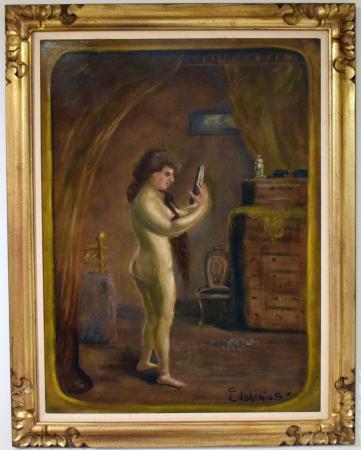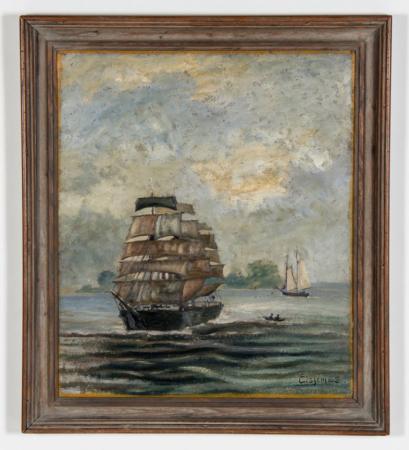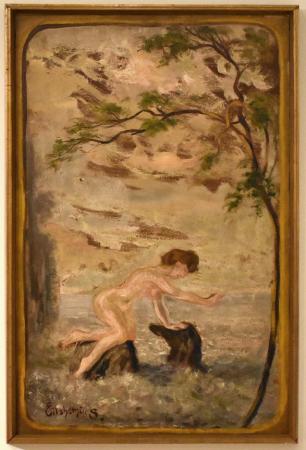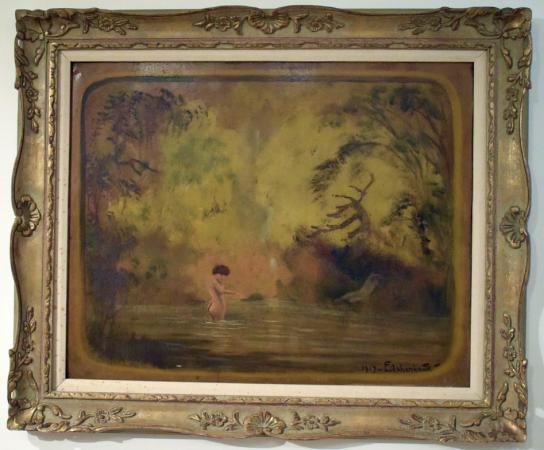Louis Michael Eilshemius

Louis Michel Eilshemius
Louis Michel Eilshemius (February 4, 1864 – December 29, 1941) was an American painter, primarily of landscapes and nudes.
Shortly after his death, Marcel Duchamp noted of Eilshemius: “He was a true individualist, as artists of our times should be, who never joined any group. This attitude is only one reason for his late recognition. He was a poet and painted like one, but his lyricism was not related to his time and expressed no definite period…. His landscapes were not landscapes of a definite country; his nudes were floating figures with no studied anatomy. His allegories were not based on accepted legends. One can hardly find words to define him. Eilshemius’ paintings speak for themselves.”
Eilshemius was a true “riches to regs” story. An idiosyncratic, eccentric and extremely prolific “outsider” artist, Louis M. Eilshemius was born in 1864 into wealth on his family’s estate, Laurel Hill Manor, in Arlington, New Jersey, to Henry G. and Cécilie Elise Eilshemius, the sixth of eight children. From a young age, Eilshemius was educated in Europe, attending school in Geneva, Switzerland and Dresden, Germany, where he received his first lessons in art. By 1881, Eilshemius had returned to New York, where his father had made his fortune in imports, and was working as a bookkeeper. He requested to study art but was denied by his father. In 1882, he enrolled at Cornell University to study agriculture, continuing to write, draw and paint on his own. Having at last obtained his father’s permission to pursue art, Eilshemius enrolled at the Art Students League from 1884 to 1886, studying privately with landscape painter Robert C. Minor. He left for Paris and subsequently studied under Bouguereau at the Académie Julian and traveled widely in Europe, Africa and the South Seas, returning to the family brownstone in New York City where he was to live for the rest of his life. His early landscapes, which show the influence of the Barbizon School and of Corot, George Inness and Albert Pinkham Ryder gained him little recognition from critics or the public. Around 1910, the element of fantasy in his work became more pronounced and his technique became coarser; henceforth, he often painted on cardboard instead of canvas. As his works became more idiosyncratic, so did his behavior, and he developed an unsettling habit of visiting galleries and loudly condemning the works on display. In another unconventional take on his artistic persona and ongoing sense of personal reinvention, he was known to sign his paintings “Elshemus,” from 1890 until 1913, when he returned to the proper spelling.
His later, visionary works depicting moonlit landscapes populated with voluptuous nymphs caused his contemporaries particular consternation, due to their crudely rendered and often extravagantly smiling nudes. These are shown frolicking in forests or waterfalls, either alone or in groups, sometimes defying gravity by floating through the air. His paintings of New York rooftops are as lyrical as his pastoral scenes, and like them are often bounded by sinuous "frames" he painted onto his pictures.
Eilshemius also wrote verse and prose, composed music, painted, philosophized and became notorious for his numerous, often vitriolic, letters-to-the-editor of various New York City publications. His lack of public acclaim led him to desperate measures: suspecting that the length of his name was responsible for his neglect, in about 1890 he began signing his paintings "Elshemus"[3] (he reverted to the original spelling in 1913). On letterheads and in hyperbolic, self-published flyers he would proclaim his accomplishments: "Educator, Ex-actor, Amateur All-around Doctor, Mesmerist-Prophet and Mystic, Reader of Hands and Faces, Linguist of 5 languages", as well as world-class athlete and marksman, "Spirit-Painter Supreme", and musician whose improvisations rivaled the compositions of Chopin. All of this only reinforced the impression, already suggested by the peculiar imagery in many of his paintings, that he was either mad or a charlatan.
He was not without supporters, however. Eilshemius was championed by Marcel Duchamp, who "discovered" Eilshemius in 1917 and invited him to exhibit with him in Paris that year. Joseph Stella was an admirer and drew a particularly fine silverpoint portrait of him. His work was generally well received by French viewers and critics; his admirers included Matisse. Duchamp subsequently helped to arrange Eilshemius's first solo exhibition in 1920, at the Société Anonyme in New York City. The hostile critical reception to this exhibition, however, finally drove him to give up painting entirely in 1921, although there is a single known painting dated 1937. The remainder of his life was dedicated to self-promotion, and in 1931 he took to referring to himself as "Mahatma." Injured in an automobile accident in 1932, he became increasingly reclusive. His health in decline and his family fortune spent, he died in 1941.
A number of exhibitions followed his death. His first retrospective, Masterpieces of Eilshemius, was organized at the Artists’ Gallery in 1959. In 1978, the Hirshorn Museum and Sculpture Garden, which has the largest collection of Eilshemius works, mounted a major retrospective. Eilshemius has sparked scholarly interest in recent years, in part due to his fascinating persona and in part due to his curious connection to Duchamp. At the height of his popularity, work by Eilshemius was collected by some of America’s most influential collectors, including Stephen C. Clark, Chester Dale, Joseph H. Hirshhorn, Roy R. Neuberger, Duncan Phillips, and Abby Aldrich Rockefeller. Prominent artists and musicians, both past and present, have collected his work.






